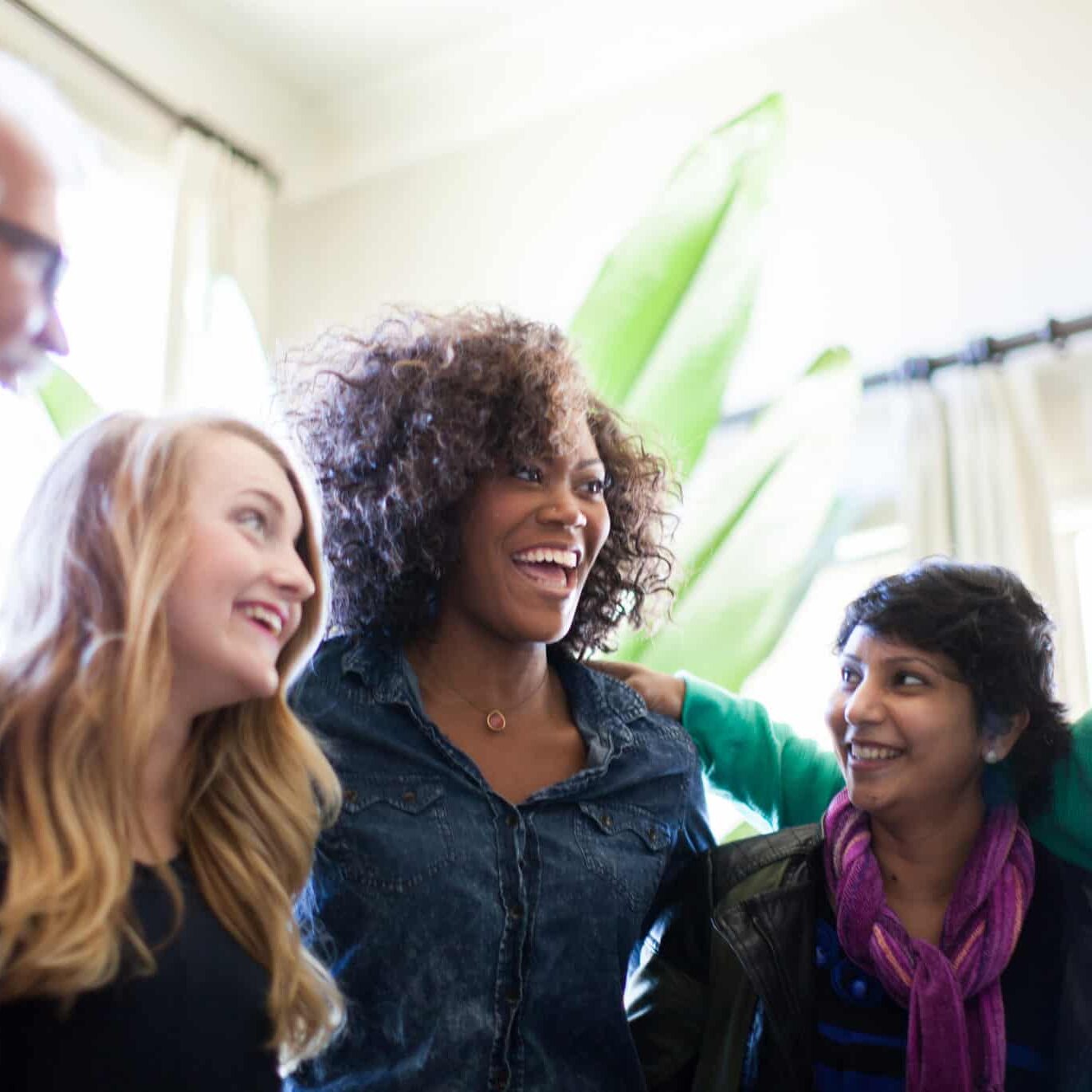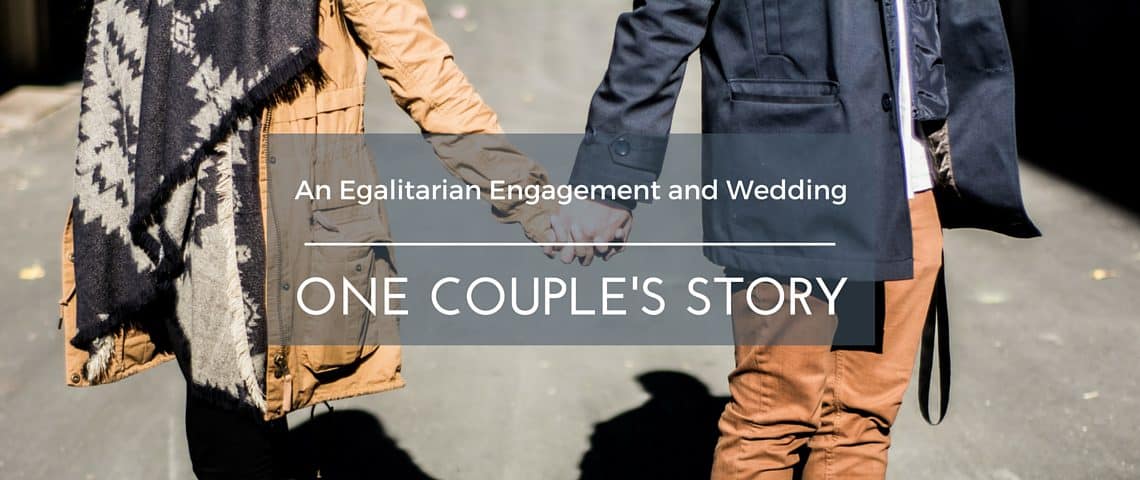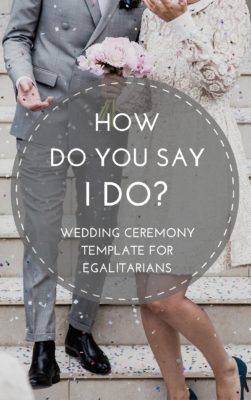Today Katie Manning shares some creative ways she and her husband, Jon, applied their egalitarian values to the engagement and wedding experience. At the end of the post is a link to our free resource for planning an egalitarian wedding ceremony.
As my husband and I approach our 12th wedding anniversary, and as we’re attending another round of friends’ weddings this summer, I find myself thinking again about the many ways “traditional” engagements and weddings in the U.S. still rely on symbols and rituals that portray women as property to be exchanged between men.
So to celebrate our anniversary, here are some things that worked for Jon and I when we wanted our engagement and wedding to reflect our egalitarian relationship.
The Proposals
The final “s” in this heading is not a typo. Jon and I had been dating for over two years and knew we wanted to get married. I decided to propose. He needed a new Bible, so I got him one as a Valentine’s Day gift, and inside I placed a homemade bookmark that said some lovely things and concluded, “Will you marry me?” His face was beaming. We were still in college and not ready to plan a wedding, so I told him that he could propose back to me when we were ready.
As if we’d stepped out of a Jane Austen novel, we were secretly engaged for about a year. (I suppose this is what happens when a literature major and a theology major fall in love.) Then Jon proposed back to me with another homemade bookmark inside a book of Shakespeare’s sonnets. We called each other’s parents to ask for their blessing to marry their child. Jon’s parents were particularly surprised and thrilled that I called to ask them.
The Rings
While we were secretly engaged, we shopped around together for rings. I had already decided that I wasn’t interested in having a diamond engagement ring. The moral issues surrounding the diamond trade are not romantic, and I found it impractical for two college students to spend a bunch of money on a ring. We decided together that we should both have rings since we were both engaged, and we settled on simple, beautiful bands that would signify our engagement and double as our wedding bands. We removed them before our wedding and re-placed them on each other during the ceremony.
The Name
We did not assume that I would take my husband’s last name. We knew that we wanted to share a last name, so we thought through all of the options together, everything from using either of our last names to hyphenating both last names to creating a new name altogether. For a variety of reasons, we decided that it worked best for us to use Jon’s last name as our married name. Even though it appears that we just did the traditional thing in this case, we came to that decision thoughtfully rather than by default.
The Ceremony
We knew that we did not want to symbolize that I was being given to Jon by my dad. This was not an exchange; Jon didn’t give my dad any cows for me. We were, in fact, two adults who chose each other. We do love our parents very much, and we wanted to involve them all in the ceremony in a meaningful way, so after our wedding party entered the sanctuary, our parents walked down the aisle together and waited for us up front. Then Jon and I entered from separate doors, met at the center aisle, and walked to the front side-by-side to symbolize that we were approaching this marriage together. Instead of a “giving away,” we had a parental blessing, and that was special.
To conclude the ceremony, we avoided collapsing our names into “Mr. and Mrs. Jon Manning” and were instead presented as a couple with both of our first names and our chosen last name. Since my identity is not subsumed under his, we didn’t want my name to be either.
I’ll save our approach to egalitarian marriage and our (mostly unsuccessful) attempts at egalitarian parenting for another time…
For now, happy anniversary, Jon, and a happy wedding season to all.
Free Resource!
A WEDDING CEREMONY FOR EGALITARIANS
This free template can be adapted to fit a couple’s unique convictions and preferences. Just click on the link to download the PDF from Dropbox.
Read more on dating and marriage:
6 DIFFERING VIEWS ON WEDDING TRADITIONS
ANATOMY OF AN EGALITARIAN WEDDING CEREMONY
6 THINGS EGALITARIAN MARRIAGE IS NOT
I’M THE BOMB: A REFLECTION ON DATING
QUESTIONS ABOUT EGALITARIAN DATING
Image Credit: Unsplash






6 responses to “An Egalitarian Engagement and Wedding: One Couple’s Story”
Was still pretty deep in the conservatism in which I was raised when I got married, but even so, insisted on a couple of things. I told the pastor that if he used the word “obey” in our vows I would not take them. (This was not a minor rebellion for me!) And I dropped my dad off at the head of the aisle to sit with my mother and walked up to my husband by myself, because I’m not a possession to be transferred ownership of from one man to another. Interesting that that’s what I came up with then! 🙂
Thanks for an informative article on how you did it. Good to read about.
I’m Dutch and in my culture it is normal that a couple buy their rings together. There is no separate engagement ring.
We walked both down the aisle in church.
We knew that we wanted to marry and that’s why there wasn’t a special proposal. We were in love and made all the decisions together.
Without realising we had a very egalitarian wedding day.
Thanks for sharing this! I’m glad to know that these things are common in your culture.
I’m a single woman, but I’ve been thinking more about egalitarian dating and marriage for some time. This is further proof for me that having an egalitarian wedding and marriage is possible. And I just downloaded the free resource. I can’t wait to dive in and set intentions for attracting a partner who wants an egalitarian wedding and marriage.
So glad this is helpful to you Nicole!
I’m glad to confirm this possibility for you! Best wishes!